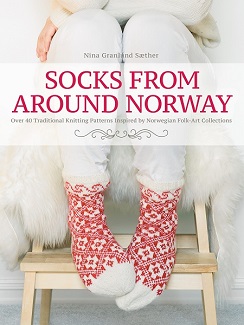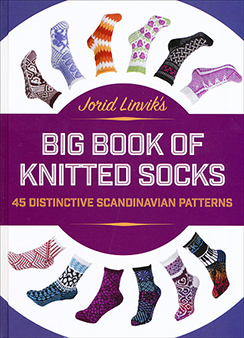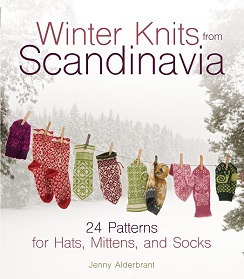Over 40 Traditional Knitting Patterns Inspired by Norwegian Folk-Art Collections
Would you be interested in discovering a treasure trove of sock knitting patterns, all of which are based on historic Norwegian patterns and techniques? And would you be especially excited if that pattern collection featured a variety of different sock styles and lengths – some that use lace knitting techniques, some that use stranded colorwork knitting techniques, some that incorporate cables, some that are ribbed, some that are striped, and even a pair worked in entrelac? And would you be interested in getting an in-depth lesson on knitting socks – including information about how to shape the toes on socks and how to knit several different types of heels for your socks?
If all of the above sounds interesting to you, there is a lovely new knitting book you’re going to want to take a look at. It’s called Socks From Around Norway: Over 40 Traditional Knitting Patterns Inspired by Norwegian Folk-Art Collections. It’s a delightful book — and if you enjoy either sock knitting or fashion history, I think you’re going to love it.
What You Need to Know About This Knitting Pattern Book:

Author: Nina Granlund Sæther
Publisher: Trafalgar Square Books
Copyright Date: This book was originally published in Norwegian. I am reviewing the English language translation of the book, which has a publication date of 2019.
ISBN 13: 978-1570769221
ISBN 10: 1570769222
Book Format:
This book is available in the following format: Hardcover without dust jacket
Number of Pages: 200
Skill Level:
The Focus of This Book:
This book is tightly focused on the topic of sock knitting, with an emphasis on historic Norwegian sock patterns. The author of the book went to extensive lengths to research the history of sock designs in Norway, and to document all the most important information she could find on the topic. She conducted much of her original research in museum archives and through historical societies.
Since actual knitting patterns are unavailable for the historic socks she found, she painstakingly interpreted each design to determine how contemporary knitters could best reproduce it. The patterns she shares in this book are her interpretations of these historic designs.
In some cases, she had to take liberties with various design elements to bring the antique designs into the present. For example, in the history section of the book preceding the pattern for her “Hardanger” socks, she reveals that the vintage socks she’s reproducing were most likely knitted with needles in the size range of 00000 / 1 mm or finer. Good luck finding a pair of such tiny needles nowadays, even on Amazon. So of course, the recommended knitting needles for Nina’s reinterpretation of these socks is much larger, enabling contemporary knitters to actually locate needles of the proper size so they can knit the socks.
Knitting Projects Included in This Book:
Included in this book are knitting patterns for making 41 different pairs of socks. Socks are the only types of projects included in this book. There are no scarves, hats, mittens or other projects — only socks. There are various socks sized for men, women, children and babies.
Some of the Additional Topics Covered in This Book:
- Two-color stranded knitting
- Yarn floats
- Two-End (twined) braid
- Entrelac
- Sock heels
- Hourglass heel
- Gusset heel
- Band heel with short heel flap
- Band heel with long heel flap
- Shaped common heel
- Afterthought heel
- Reinforcing the heel
- Toe shaping
- Star toe
- Wedge toe
- Weaving in yarn ends
- Garment care
The Best Things About This Book
The sock knitting patterns in this book are outstanding. If you’re a crafter, and you enjoy knitting socks, this book is likely to appeal to you. There’s a broad variety of lovely, classic sock patterns presented here. The patterns that the author, Nina, has included are all ones that remain as useful, relevant and wearable today as they were 100+ years ago when the original inspiration pieces were in use.
This is as much a history book as it is a knitting pattern book. However, it isn’t a dull or dry one. The text is simply fascinating. Nina presents the known history of Norwegian sock knitting using archival photographs and historic records. She masterfully uses these elements to weave together the sorts of human-interest stories that sock knitters are likely to find compelling.
I learned soooo much from reading this book — and you will, too. For example — did you know that Norwegian cable knit socks appear to pre-date Irish aran patterns? How fascinating! There are bunches of interesting tidbits like this one incorporated into the text of the book.
The book includes a bibliography, which I am sure history buffs will find helpful and interesting. If you want to do further study, the resources listed in the bibliography will be a helpful starting point.
Other Observations About This Book
The photography and styling in this book are super creative without being overly distracting. The photographer, Guri Pfeifer, appears to have a good grasp on what knitters like to see when they are trying to reproduce a project from a knitting pattern. Guri did a wonderful job of capturing these socks in a realistic and appealing way.
The majority of the socks are presented in at least two ways — on a human model, and laid flat. Having both types of presentations is really helpful. It maximizes your understanding of how the original project samples fit on a human body, plus it gives you a clearer look at the stitch patterns you’re trying to reproduce. In a couple of cases, small areas on the model photos are blurred or obscured, but you still have all the information you need to accurately knit the socks, thanks to the presence of the detail photos.
These socks are all knitted from the cuff down. The patterns are written for use with sets of 5 double-pointed knitting needles.
Conclusion
What you have here is a valuable reference that will be immensely useful to several different groups of people. First of all, I enthusiastically recommend this book to other knitting enthusiasts, particularly to sock knitters and aspiring sock knitters.
I also recommend this book to fashion designers, costume designers and history buffs.
Where to Buy This Book:
- Click here to shop for this book at Amazon.
- Click here to shop for this book at the publisher’s website.
More Lovely Sock Knitting Books You Should Know About
- Jorid Linvik’s Big Book of Knitted Socks — Some socks are just socks. Other socks have tangible “personality”. If you’re in search of remarkable sock knitting patterns featuring animals and design themes with personality that shines through, Jorid Linvik’s sock patterns are likely to be exactly what you want. These socks are pretty amazing overall.
- Knit Socks for Those You Love — If you’d rather not have people staring at your feet and complimenting your socks all day long, this may be a better choice of pattern books for you. These socks are definitely beautiful and appealing, but most of them are solid-colored socks that are less likely to attract attention. The 2 exceptions are a pair of multicolored, bright tweed socks and a pair of bold and colorful slip stitch socks that are made with a self-striping yarn. All the socks included in this book are stylish and wearable.
- Winter Knits From Scandinavia — This lovely book features patterns for knitting mittens, socks, hats and other winter accessories. The majority of the patterns are mitten patterns, but the 3 sock patterns included in the book are simply exquisite ones.
- The Cable Knitter’s Guide — If you’d be interested in knitting socks that feature unique cabled details, this book is worth your consideration. Sock patterns aren’t the sole focus of this book, but there are multiple lovely sock patterns included — along with patterns for many other types of clothing, accessories and home decor items. The book also doubles as a stitch dictionary that’s exclusively focused on cable patterns — so if you would like to design your own knitting projects, this book will be a useful reference for that purpose.
- Click here to find more of my picks for the best sock knitting books.


Posted By: Amy Solovay
This page was last updated on 8-5-2023.